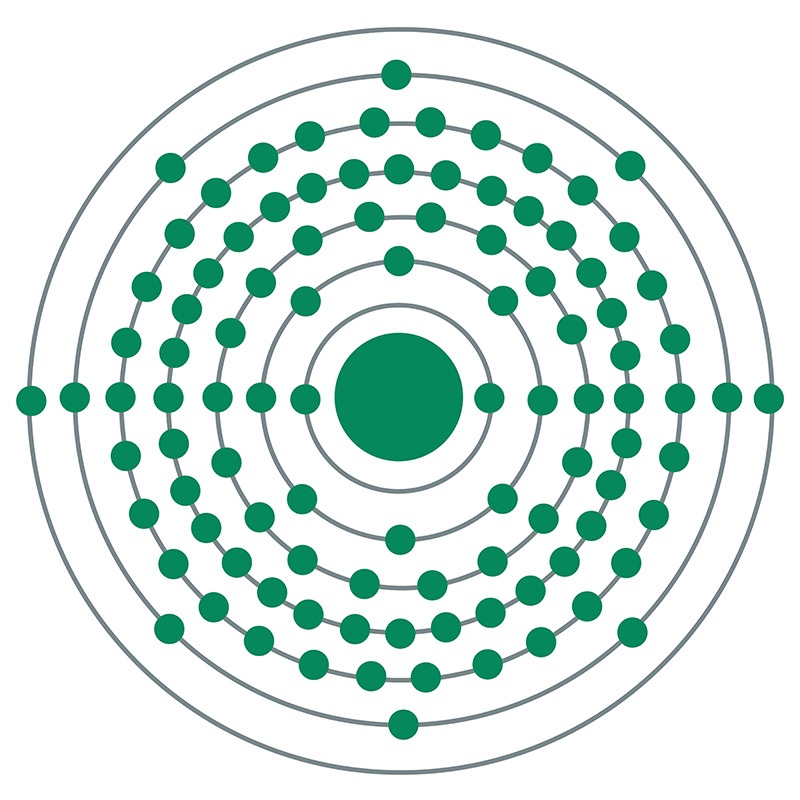Math Is Fun Forum
You are not logged in.
- Topics: Active | Unanswered
- Index
- » Science HQ
- » Fermium
Pages: 1
#1 2025-10-09 16:06:39
- Jai Ganesh
- Administrator

- Registered: 2005-06-28
- Posts: 52,614
Fermium
Fermium
Gist
Fermium (Fm) is a synthetic, radioactive element with atomic number 100, discovered in 1953 and named after physicist Enrico Fermi. It is an actinide created by neutron bombardment of lighter elements in nuclear reactions and is highly unstable, with no known natural occurrence or commercial uses, though it is significant for research into transuranic elements.
Fermium has no commercial uses; its only application is in scientific research, particularly in nuclear physics to study heavy elements, decay processes, and super-heavy elements. Due to its scarcity, artificial creation in microscopic quantities, and short-lived isotopes, fermium's use is confined to the laboratory, where it serves as a target material in nuclear reactors, a source of high-energy alpha particles, and a calibration tool for nuclear instrumentation.
Summary
Fermium is a synthetic chemical element; it has symbol Fm and atomic number 100. It is an actinide and the heaviest element that can be formed by neutron bombardment of lighter elements, and hence the last element that can be prepared in macroscopic quantities, although pure fermium metal has not been prepared yet. A total of 20 isotopes are known, with 257Fm being the longest-lived with a half-life of 100.5 days.
Fermium was discovered in the debris of the first hydrogen bomb explosion in 1952, and named after Enrico Fermi, one of the pioneers of nuclear physics. Its chemistry is typical for the late actinides, with a preponderance of the +3 oxidation state but also an accessible +2 oxidation state. Owing to the small amounts of produced fermium and all of its isotopes having relatively short half-lives, there are currently no uses for it outside basic scientific research.
Details
Fermium (Fm) is a synthetic chemical element of the actinoid series of the periodic table, atomic number 100. Fermium (as the isotope fermium-255) is produced by the intense neutron irradiation of uranium-238 and was first positively identified by American chemist Albert Ghiorso and coworkers at Berkeley, California, in debris taken from the first thermonuclear (hydrogen bomb) test explosion (November 1952), “Mike,” in the South Pacific. The element was named after the Italian-born American physicist Enrico Fermi.
All fermium isotopes are radioactive. Mixtures of the isotopes fermium-254 (3.24-hour half-life), fermium-255 (20.1-hour half-life), fermium-256 (2.6-hour half-life), and fermium-257 (100.5-day half-life) have been produced in a high-neutron-flux reactor by the intense slow-neutron irradiation of elements of lower atomic number, such as plutonium.
The stability of the isotope fermium-257 would make it possible to work with weighable amounts of fermium. However, the only practical production method of fermium, multiple neutron capture in a high-flux reactor, has yielded only picogram (1 picogram = {10}^{-12} gram) amounts of fermium-257, too small to carry out chemistry with pure samples. Therefore, all studies of fermium chemistry have been done on the tracer scale. Fermium exists predominantly in the +3 oxidation state; there is also evidence for the +2 state under highly reducing conditions, paralleling the oxidation-reduction behaviour of the lanthanoid ytterbium. Pure fermium metal has not been prepared, but volatility studies have been carried out with alloys that are dilute solutions of fermium metal in samarium and ytterbium, indicating that fermium appears to be a divalent metal. Fermium-250 (30-minute half-life), the alpha-decay product of nobelium, was used to ascertain the existence of nobelium-254.
Element Properties
atomic number : 100
stablest isotope : 257
oxidation states : +2, +3.
Additional Information:
Appearance
A radioactive metal obtained only in microgram quantities.
Uses
Fermium has no uses outside research.
Biological role
Fermium has no known biological role. It is toxic due to its radioactivity.
Natural abundance
Fermium can be obtained, in microgram quantities, from the neutron bombardment of plutonium in a nuclear reactor.

It appears to me that if one wants to make progress in mathematics, one should study the masters and not the pupils. - Niels Henrik Abel.
Nothing is better than reading and gaining more and more knowledge - Stephen William Hawking.
Offline
Pages: 1
- Index
- » Science HQ
- » Fermium